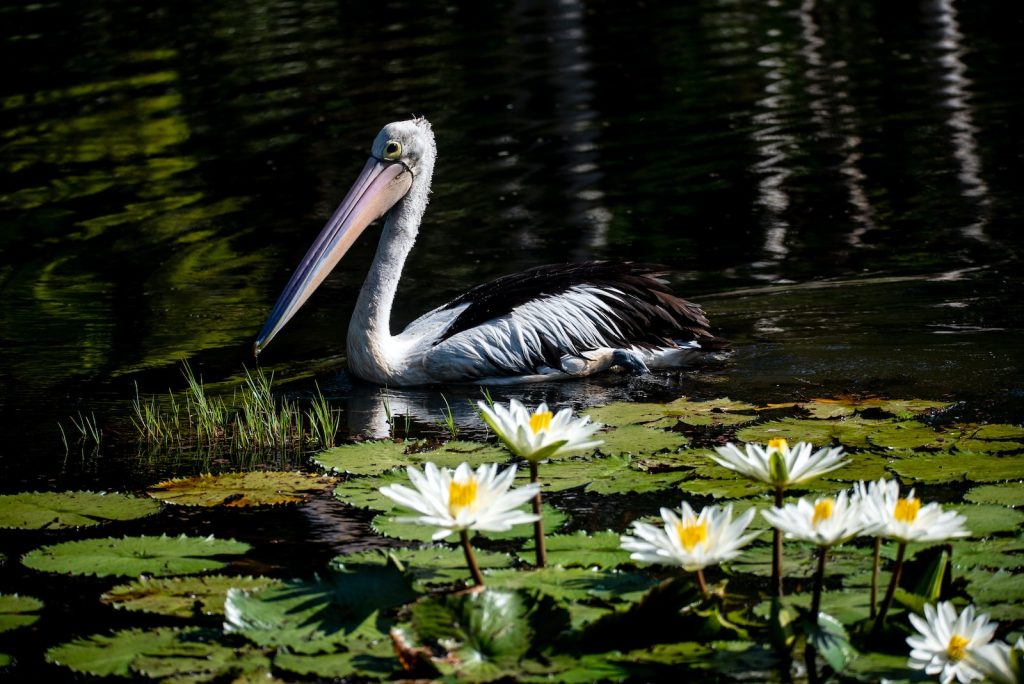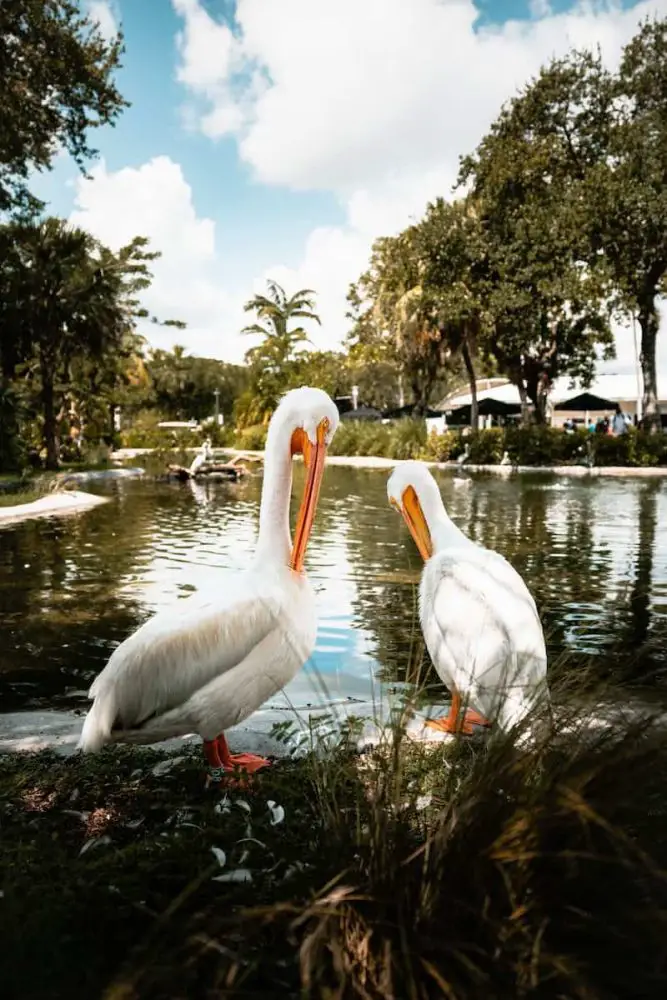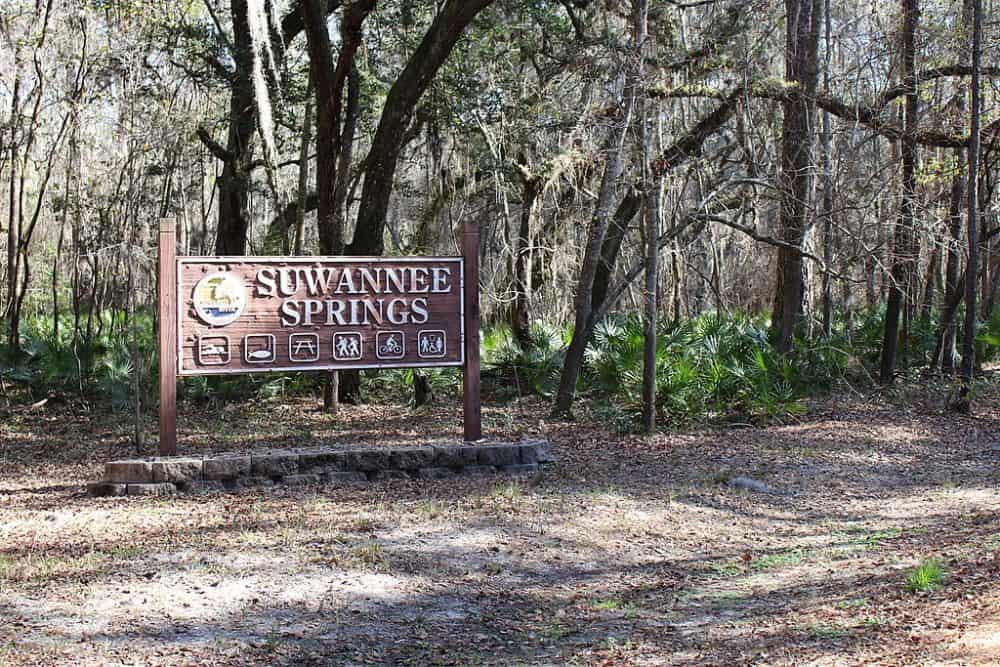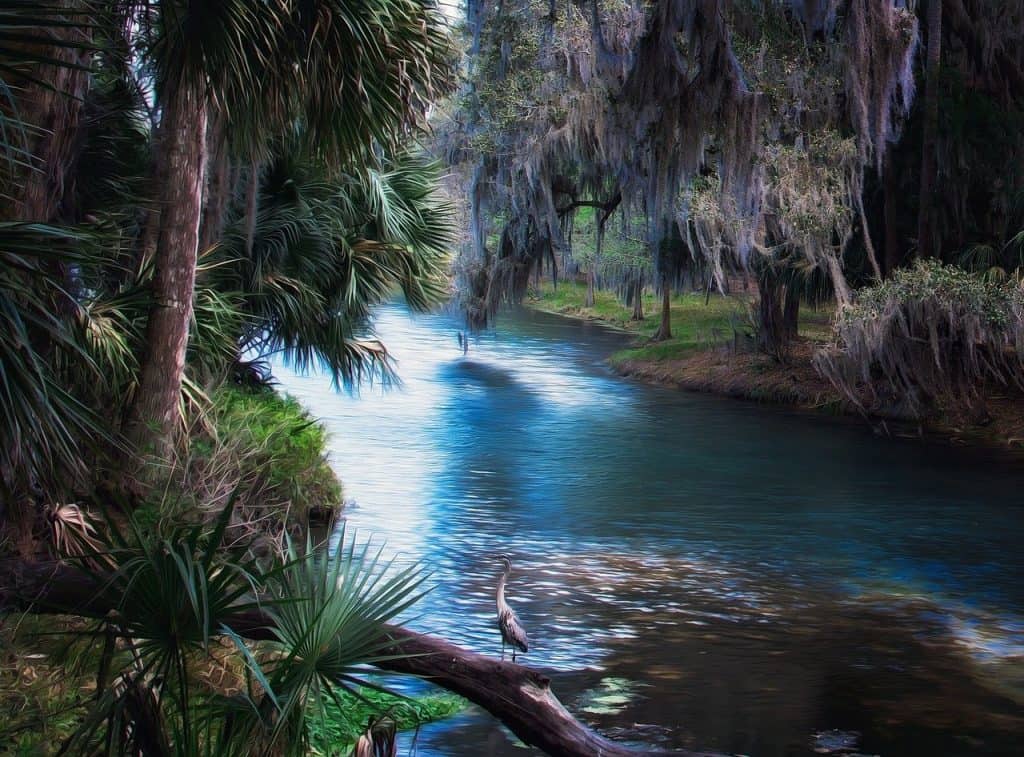White Pelicans in Florida have become a beautiful sight to behold! This majestic species of bird can be found throughout the Sunshine State and can be seen basking in the sun while they soar through the air.
Whether it’s fishing on the beach or gliding over inland waterways, these birds bring a sense of awe and wonder to any onlookers.
From the mountains and plains of the western United States, many migrate nonstop to Florida. Like all snowbirds, they migrate north in the spring.
One of the biggest birds in North America is the white pelican with a wingspan of 9 feet. They frequently fly in formation and are beautiful in the air.
For white pelicans, who often feed on lakes, life becomes too difficult when the first frost arrives in northwest Canada and the USA. Early in the fall, the water begins to freeze, driving the birds relentlessly south.
In October, around 1,500 birds congregate on Florida’s lakes. Brown pelicans reside year-round in the area, which is another notable characteristic.
The white species is distinct from its brown cousin not just in terms of migration patterns but also in terms of humorous hunting customs.
While the white pelicans form semicircles on the water’s surface and draw the fish closer to the banks where they can eventually catch it in the shallow water, the brown pelicans dive for fish.
Their amusing pouches make excellent fishnets. White pelicans remain in Florida until March when they return to their native lands to warm northern lakes in April.
For those who are interested in learning more about White Pelicans in Florida, this article will provide insight into their behavior, habitat, and diet.
Are White Pelicans Rare In Florida?
White pelicans aren’t considered endangered or threatened, but they are very rare in Florida.
White pelicans can be found in both freshwater and saltwater environments such as lakes and rivers. They aren’t found often in Florida because of the state’s geography and climate.
White pelicans are found in Florida’s Everglades and the marshes surrounding the Gulf of Mexico.

White pelicans were once a rare sight in Florida. They were usually only visible during winter months. Their population has steadily increased in Florida over the last few decades. They can be found in Florida all year, but they are still quite rare.
White pelicans are rare in Florida due to their very particular diet. They eat primarily fish and crayfish and require large water bodies with abundant fish populations to survive.
These birds also need large nesting and resting areas, which is not common in Florida.
The Migratory Bird Treaty Act protects white pelicans. This makes it illegal to kill or hunt these birds. Their population has increased in Florida through conservation efforts such as habitat restoration, protection, and other measures.
Although White pelicans may not be very common, they are still a rare sighting.
It is possible for their population to continue growing in Florida if there are proper conservation efforts and legal protection. This will make it easier to spot them in the wild.
Where To See White Pelicans, Spectacular Birds Wintering In Florida
White pelicans, with their magnificent wingspans and impressive bills, are a sight to behold.
If you’re interested in watching these amazing creatures, then Florida is one of the best places to go!
From Everglades National Park to St. Marks National Wildlife Refuge, there are plenty of areas where you can observe white pelicans and learn more about their unique behaviors.

Our Top 5 Spots To Look For White Pelicans In Florida:
1. The Florida Everglades
This is an extensive wetland that offers a great habitat for many bird species, including white pelicans. They are renowned for their distinctive appearance and large size. However, they are more common in the southerly portion of the park.
- Everglades National Park: With plenty of fish and other crayfish, the park’s vast wetlands provide a perfect habitat for white pelicans. You can often see white pelicans flying above the park or perched on trees along its waterways. The park is home to White Pelicans, which migrate from North Dakota and Canada for warmer weather in the winter.
- The Anhinga Trail: A great place to spot white pelicans in Florida’s Everglades. The popular trail runs through a sawgrass marsh with a boardwalk offering great views of the wildlife. The trail is often populated by white pelicans that can be seen perched on trees or flying overhead.
- Shark Valley Visitor Center: is another great place to see white pelicans in Florida’s Everglades. To see the birds in their natural habitat, visitors can either take a tram tour of the center or hike along the nature trails. The park provides a great location for white pelican sightings. It is home to both fish and crayfish, which are what white pelicans eat. They also have shallow water that makes it easy to hunt.
- The Ernest F. Coe Visitor Center: offers great views of the Everglades and white pelicans. A tower with panoramic views overlooks the surrounding wetlands giving the center a unique view of the area. White pelicans can often be seen perched on trees or flying overhead from the observation tower. You can also join a guided bird-watching tour, or hike the nature trails to get up close and personal with these birds.
You can enjoy a guided boat tour through the Everglades for a more intimate experience. This will allow them to spot white pelicans in their natural habitat.
Guided trips through Florida’s Everglades are offered by many canoe and airboat rental companies as well as park-approved tour guides. This is a great way for white pelicans to be seen in their natural habitat.
2. Gulf Coast
With abundant fish and many roosting spots, the marshes and estuaries of the Gulf Coast make an ideal habitat. You can often see white pelicans flying along the coast or perched on sandy beaches.
The beautiful beaches and warm waters of the Gulf Coast of Florida are a draw for nature lovers and bird watchers. White pelicans can be seen along the Gulf Coast in many locations including marshes and estuaries.
- The St. Marks National Wildlife Refuge: is a great place to spot white pelicans on the Florida Gulf Coast. It is located along the Gulf Coast, and it is home to many bird species including white pelicans. These birds can be seen in their natural habitat by visitors who take a guided tour of the refuge or follow nature trails. Visitors can spot thousands of migratory birds at the refuge, including pelicans nesting in the trees and feeding in the water just offshore.
- The Egmont Key State Park: Another great spot to see white pelicans on the Florida Gulf Coast. The island park, which is accessible only by boat, is located just off the coast of St. Petersburg. The island is accessible by boat or ferry. This allows visitors to view white pelicans in their natural habitat. It is home to a large population of white pelicans, so it can be an excellent spot to view them in winter.
- The Don C. Skinner Jr./Sara M. Skinner Preserve: This preserve is located in Southwest Florida and hosts a variety of bird species including white pelicans. The nature trails can be hiked and the birds can be viewed from observation platforms.
- The Rookery Bay National Estuarine Research Reserve: One of the best spots to bird-watch along the Gulf Coast of Florida. There are also the Crooked River State Park and Homosassa Spring Wildlife State Parks, Cedar Key Scrub State Reserve, and Chassahowitzka National Wildlife Refuge.
3. Florida Keys
A large number of white pelicans live in the Florida Keys. The Keys’ clear blue waters provide a perfect habitat for fish which attracts pelicans. Pelicans can be seen roosting along sandy beaches and eating in the water just offshore.
The Florida Keys is a group of islands off the coast of Florida. They are known for their clear blue waters and sandy beaches. It is also home to a variety of wildlife.
This makes it an ideal destination for nature lovers and bird watchers.
The Florida Keys are home to white pelicans, which can be seen in many locations across the chain.
- The Key West National Wildlife Refuge: A great place to spot white pelicans in the Florida Keys. Visitors can either take a guided tour of the refuge or follow nature trails to view these birds in their natural habitat. Mangrove islands provide a perfect habitat for birds to rest and feed, as well as nesting sites.
- The John Pennekamp Coral Reef State Park: Another great spot to see white pelicans in the Florida Keys. The park is located in Key Largo Florida. It is well-known for its coral reefs that provide an ideal environment for many marine species, including white pelicans. These birds can be seen by visitors on a glass-bottom boat trip, as well as snorkeling and diving.
- The White Pelican Population lives in Dry Tortugas National Park: 70 miles west of Key West. Visitors can also spot them in their natural habitat. You can enjoy the park’s natural beauty and wildlife by taking a boat or seaplane trip.
- The Florida Keys also has the Great White Heron National Wildlife Refuge and Crocodile lake National Wildlife Refuge. There is also the Key Largo Hammocks State Botanical Site on the mainland.
4. Sanibel Island
- J.N. “Ding” Darling National Wildlife Refuge: This 6,400-acre refuge includes mangrove forests, marshes and tidal lakes. It is an ideal habitat for many bird species including white pelicans. These birds can be seen in their natural habitat by visitors who take either a guided tour or hike along the nature trails. Many species of songbirds, wading birds, and shorebirds can also be found at the refuge.
- The Sanibel-Captiva Conservation Foundation’s Nature Center: Another great place to see white pelicans. Guided nature walks and bird-watching tours are offered by the center, which offers great opportunities to spot white pelicans as well as other species of birds that are often found on the island.
- Sanibel Island Lighthouse Beach Park: The park provides a walk along the beach with stunning views of the Gulf of Mexico. It also offers a vantage point from which to view the pelicans as they feed.
You can also spot white pelicans at the Sanibel Island Causeway or on the Gulf of Mexico beaches. You can park your car or bike on the causeway to have a look at the pelicans, or ride or drive on the Gulf of Mexico Dr.
This scenic route offers stunning views of the Gulf as well as the birds.
5. Punta Gorda
An ideal location for bird-watching or nature lovers. The area is home to many fish and has several roosting spots that make it a great spot for white pelicans.
-
- The Charlotte Harbor Environmental Center: A great place to spot white pelicans close to Punta Gorda. It is situated on the banks of the Peace River and offers a great habitat for many bird species including white pelicans. You can join a guided bird-watching tour, or hike the nature trails to view these birds in their natural habitat.
- The Alligator Creek Preserve: Another great place to see white pelicans close to Punta Gorda. This preserve can be found on the banks at Alligator Creek. It is a great spot to view a variety of birds including white pelicans. The observation platform allows visitors to observe birds from the observation deck and can be hiked along the nature trails.
- Punta Gorda is also close to Charlotte Harbor Aquatic Preserve: This largely protected estuary provides a vital habitat for many species of fish, birds, and other wildlife. With its rich aquatic ecosystem, white pelicans frequent the Aquatic preserve, where they can be seen flying overhead and roosting in nearby trees. This gives them the opportunity to be seen in the wild.
- The Peace River Wildlife Center: Another spot where you can see white pelicans close to Punta Gorda. It is a rehabilitation center that takes in injured orphaned wild birds. There are observation decks where you can spot many birds, including white pelicans.

Where Do Florida Pelicans Sleep At Night?
Pelicans in Florida often roost at night on small islands, sandbars, or man-made structures such as navigation markers and pilings.
These structures are found in estuaries and marshes along with lagoons and lagoons. The location of the pelican’s nest will vary depending on its species and the availability of suitable roosting spots.
American White Pelicans, a Florida native, often roost on large islands or sandbars in large numbers. They will roost where they have easy access and protection from predators.
They often return to the same spot each spring and will roost there year after year. Because they have a greater chance of detecting predators and human disturbance, they will roost in large groups.
The Brown pelican, however, is found in Florida and tends to nest along beaches, islands, and rocky cliffs. However, they also roost on man-made structures like oil platforms, jetties, and navigational markers.
Pelicans tend to roost in tight groups, their heads under their wings. Pelicans use this behavior to keep warm during the night and conserve energy. This is also a way for them to avoid predators.
It is important to note that pelicans don’t build nests. Therefore, the ideal roosting area will be one where they can rest or perch.
According to their species, Florida pelicans have their own roosting areas. These include small islands, sandbars beaches, beaches, and rocky cliffs.
Man-made structures such as pilings or navigation markers can also be used. It is a common behavior that provides protection and lowers energy consumption.
How White Pelicans Feed?
White pelicans, large waterbirds, are often found in groups and use a variety of strategies to catch fish.
Cooperative hunting is a common method. A group of pelicans works together to bring fish into shallow waters, making it easier to catch them.
Pelicans will swim in a straight line facing the wind, with their wings spread out, creating a barrier for the fish to swim through. The pelicans will grab the fish on their large bills as they become trapped.
White pelicans also use dip-feeding. Dip-feeding is when a group of pelicans swim together with their bills open and grab fish and other aquatic prey while they swim.
This is usually done in deeper waters, which makes it more difficult for the pelicans and their fish to be herded.
Sometimes, white pelicans will also “plunge-dive” to catch fish and crustaceans. This method is used when the pelicans are on their own and not in a group.
White pelicans eat primarily fish, crustaceans and amphibians. They can consume many pounds of fish in one day.
White pelicans are generally opportunistic feeders. They use many strategies to catch food. They adapt their feeding strategies to the environment and prey availability.
Other Places To Spot White Pelicans in Florida
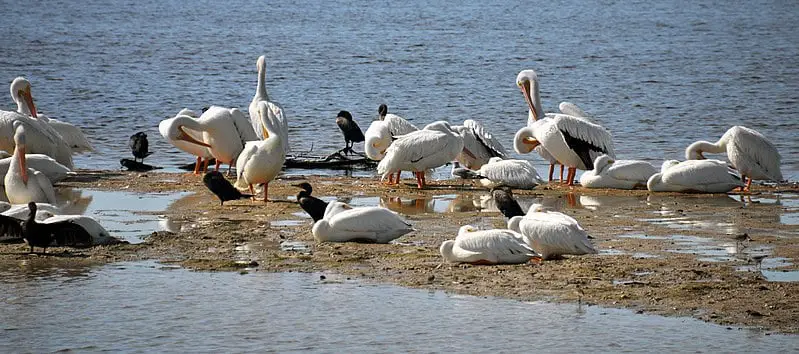
Florida has many small towns where you can see white pelicans in the wild.
These towns include:
- Cedar Key: Cedar Key is a small Florida town that is well-known for bird-watching opportunities. It is also home to Cedar Key Scrub State Reserve. Here, white pelicans can be often seen feeding in the water and roosting on islands.
- St. Augustine: This historic coastal community is home to Anastasia State Park. It is a popular spot where you can bird-watch. The park is home to white pelicans, which can be found along the beaches and in the water surrounding it.
- Tarpon Springs: This Gulf Coast resort is well-known for its sponge diving industry. It is also home to Fred Howard Park which provides great opportunities to view white pelicans while taking in the sunset.
- Punta Gorda: This Gulf Coast town houses the Charlotte Harbor Aquatic Preserve. It is a popular spot to bird watch and is well-known for its large population of white pelicans. They can often be found roosting on islands or feeding in the water around the town.
- Homosassa Springs: is a small town on the Gulf Coast that is well-known for its Homosassa Springs Wildlife State Park. This park offers birdwatching opportunities and allows visitors to spot wild white pelicans.
The first wildlife refuge in the country was located on Pelican Island in the Indian River Lagoon. It was maintained because it was a brown pelican nesting habitat, but wintering white pelicans also go there.
This is not a complete list.
While brown pelicans within peninsular Florida usually nest in mangroves or other trees, white pelicans build nests right on the ground. They clear or scrape an area and rim it with dirt, sticks, or other debris.
Florida pelicans have specific roosting locations depending on their species, these range from small islands, sandbars, beaches, rocky cliffs, and man-made structures, such as pilings and navigation markers.
Roosting in large groups is a common behavior that provides protection and reduces energy consumption.
Overall, the pelican’s roosting habits are an interesting aspect of their biology, and it is worth taking note of where they choose to rest at night during your next bird-watching excursion.
White pelicans are a rare sight in Florida, but they can be found in the Everglades National Park and Gulf Coast, especially during the winter months.
These locations provide the ideal habitat for white pelicans with plenty of fish and crayfish to feed on, and suitable roosting sites.
With a little patience and a keen eye, you may be able to catch a glimpse of these magnificent birds in their natural habitat.

